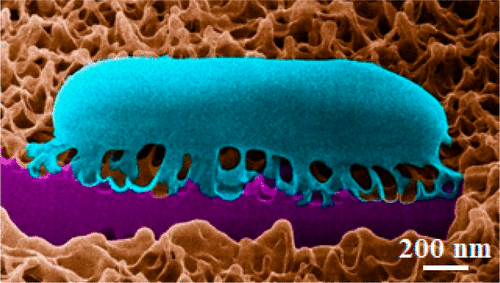当前位置:
X-MOL 学术
›
ACS Biomater. Sci. Eng.
›
论文详情
Our official English website, www.x-mol.net, welcomes your
feedback! (Note: you will need to create a separate account there.)
Resolving Bio–Nano Interactions of E. coli Bacteria–Dragonfly Wing Interface with Helium Ion and 3D-Structured Illumination Microscopy to Understand Bacterial Death on Nanotopography
ACS Biomaterials Science & Engineering ( IF 5.4 ) Pub Date : 2020-06-09 , DOI: 10.1021/acsbiomaterials.9b01973 Chaturanga D. Bandara 1, 2 , Giulia Ballerin 1 , Miika Leppänen 3 , Tuquabo Tesfamichael 2 , Kostya Ken Ostrikov 2 , Cynthia B. Whitchurch 1
ACS Biomaterials Science & Engineering ( IF 5.4 ) Pub Date : 2020-06-09 , DOI: 10.1021/acsbiomaterials.9b01973 Chaturanga D. Bandara 1, 2 , Giulia Ballerin 1 , Miika Leppänen 3 , Tuquabo Tesfamichael 2 , Kostya Ken Ostrikov 2 , Cynthia B. Whitchurch 1
Affiliation

|
Obtaining a comprehensive understanding of the bactericidal mechanisms of natural nanotextured surfaces is crucial for the development of fabricated nanotextured surfaces with efficient bactericidal activity. However, the scale, nature, and speed of bacteria–nanotextured surface interactions make the characterization of the interaction a challenging task. There are currently several different opinions regarding the possible mechanisms by which bacterial membrane damage occurs upon interacting with nanotextured surfaces. Advanced imaging methods could clarify this by enabling visualization of the interaction. Charged particle microscopes can achieve the required nanoscale resolution but are limited to dry samples. In contrast, light-based methods enable the characterization of living (hydrated) samples but are limited by the resolution achievable. Here we utilized both helium ion microscopy (HIM) and 3D structured illumination microscopy (3D-SIM) techniques to understand the interaction of Gram-negative bacterial membranes with nanopillars such as those found on dragonfly wings. Helium ion microscopy enables cutting and imaging at nanoscale resolution, while 3D-SIM is a super-resolution optical microscopy technique that allows visualization of live, unfixed bacteria at ∼100 nm resolution. Upon bacteria–nanopillar interaction, the energy stored due to the bending of natural nanopillars was estimated and compared with fabricated vertically aligned carbon nanotubes. With the same deflection, shorter dragonfly wing nanopillars store slightly higher energy compared to carbon nanotubes. This indicates that fabricated surfaces may achieve similar bactericidal efficiency as dragonfly wings. This study reports in situ characterization of bacteria–nanopillar interactions in real-time close to its natural state. These microscopic approaches will help further understanding of bacterial membrane interactions with nanotextured surfaces and the bactericidal mechanisms of nanotopographies so that more efficient bactericidal nanotextured surfaces can be designed and fabricated, and their bacteria–nanotopography interactions can be assessed in situ.
中文翻译:

利用氦离子和3D结构的照明显微镜解析大肠杆菌细菌-蜻蜓翼界面的生物-纳米相互作用,以了解纳米地形图上的细菌死亡。
全面了解天然纳米纹理表面的杀菌机理对于开发具有有效杀菌活性的纳米纹理表面至关重要。然而,细菌-纳米纹理表面相互作用的规模,性质和速度使相互作用的表征成为一项艰巨的任务。目前,关于与纳米纹理化表面相互作用时细菌膜损伤发生的可能机理有几种不同的观点。先进的成像方法可以通过使交互可视化来澄清这一点。带电粒子显微镜可以达到所需的纳米级分辨率,但仅限于干燥样品。相比之下,基于光的方法可以表征活(水合)样品,但受限于可实现的分辨率。在这里,我们利用氦离子显微镜(HIM)和3D结构照明显微镜(3D-SIM)技术来了解革兰氏阴性细菌膜与纳米柱(如蜻蜓翅膀上的纳米柱)的相互作用。氦离子显微镜可实现纳米级分辨率的切割和成像,而3D-SIM是一种超分辨率光学显微镜技术,可在约100 nm分辨率下可视化未固定的活细菌。根据细菌与纳米柱的相互作用,估算了由于天然纳米柱弯曲而存储的能量,并将其与垂直排列的碳纳米管进行了比较。在相同的挠度下,与碳纳米管相比,较短的蜻蜓翅膀纳米柱存储的能量稍高。这表明,人造表面可以达到与蜻蜓翅膀相似的杀菌效率。接近自然状态的细菌-纳米柱相互作用的原位表征。这些微观方法将有助于进一步了解细菌膜与纳米结构表面的相互作用以及纳米形貌的杀菌机理,从而可以设计和制造更有效的杀菌纳米结构表面,并且可以就地评估其细菌-纳米形貌相互作用。
更新日期:2020-07-13
中文翻译:

利用氦离子和3D结构的照明显微镜解析大肠杆菌细菌-蜻蜓翼界面的生物-纳米相互作用,以了解纳米地形图上的细菌死亡。
全面了解天然纳米纹理表面的杀菌机理对于开发具有有效杀菌活性的纳米纹理表面至关重要。然而,细菌-纳米纹理表面相互作用的规模,性质和速度使相互作用的表征成为一项艰巨的任务。目前,关于与纳米纹理化表面相互作用时细菌膜损伤发生的可能机理有几种不同的观点。先进的成像方法可以通过使交互可视化来澄清这一点。带电粒子显微镜可以达到所需的纳米级分辨率,但仅限于干燥样品。相比之下,基于光的方法可以表征活(水合)样品,但受限于可实现的分辨率。在这里,我们利用氦离子显微镜(HIM)和3D结构照明显微镜(3D-SIM)技术来了解革兰氏阴性细菌膜与纳米柱(如蜻蜓翅膀上的纳米柱)的相互作用。氦离子显微镜可实现纳米级分辨率的切割和成像,而3D-SIM是一种超分辨率光学显微镜技术,可在约100 nm分辨率下可视化未固定的活细菌。根据细菌与纳米柱的相互作用,估算了由于天然纳米柱弯曲而存储的能量,并将其与垂直排列的碳纳米管进行了比较。在相同的挠度下,与碳纳米管相比,较短的蜻蜓翅膀纳米柱存储的能量稍高。这表明,人造表面可以达到与蜻蜓翅膀相似的杀菌效率。接近自然状态的细菌-纳米柱相互作用的原位表征。这些微观方法将有助于进一步了解细菌膜与纳米结构表面的相互作用以及纳米形貌的杀菌机理,从而可以设计和制造更有效的杀菌纳米结构表面,并且可以就地评估其细菌-纳米形貌相互作用。











































 京公网安备 11010802027423号
京公网安备 11010802027423号